Teaching general english in the development of artificial intelligence
Ngày nay tiếng Anh là ngôn ngữ giao tiếp toàn cầu, do đó công tác giảng dạy
tiếng Anh, đặc biệt là tiếng Anh không chuyên trong các trường Đại học, là một mắt xích
không thể tồn tại bên ngoài quá trình toàn cầu hóa và quốc tế hóa. Trong bài viết này,
chúng tôi cung cấp cái nhìn tổng thể về vị thế của người sử dụng tiếng Anh trong việc thúc
đấy công tác giảng dạy ngoại ngữ nhằm phục vụ nền kinh tế toàn cầu; Để bắt kịp với tiến
trình hội nhập và toàn cầu hóa, việc giảng dạy tiếng Anh ở các trường Đại học vẫn phải
đối mặt với nhiều cơ hội và thách thức nhất định; Sự phát triển của công nghệ thông tin
đã ảnh hưởng tích cực và phần nào định hình cho việc giảng dạy tiếng Anh trong bối cảnh
hiện tại.
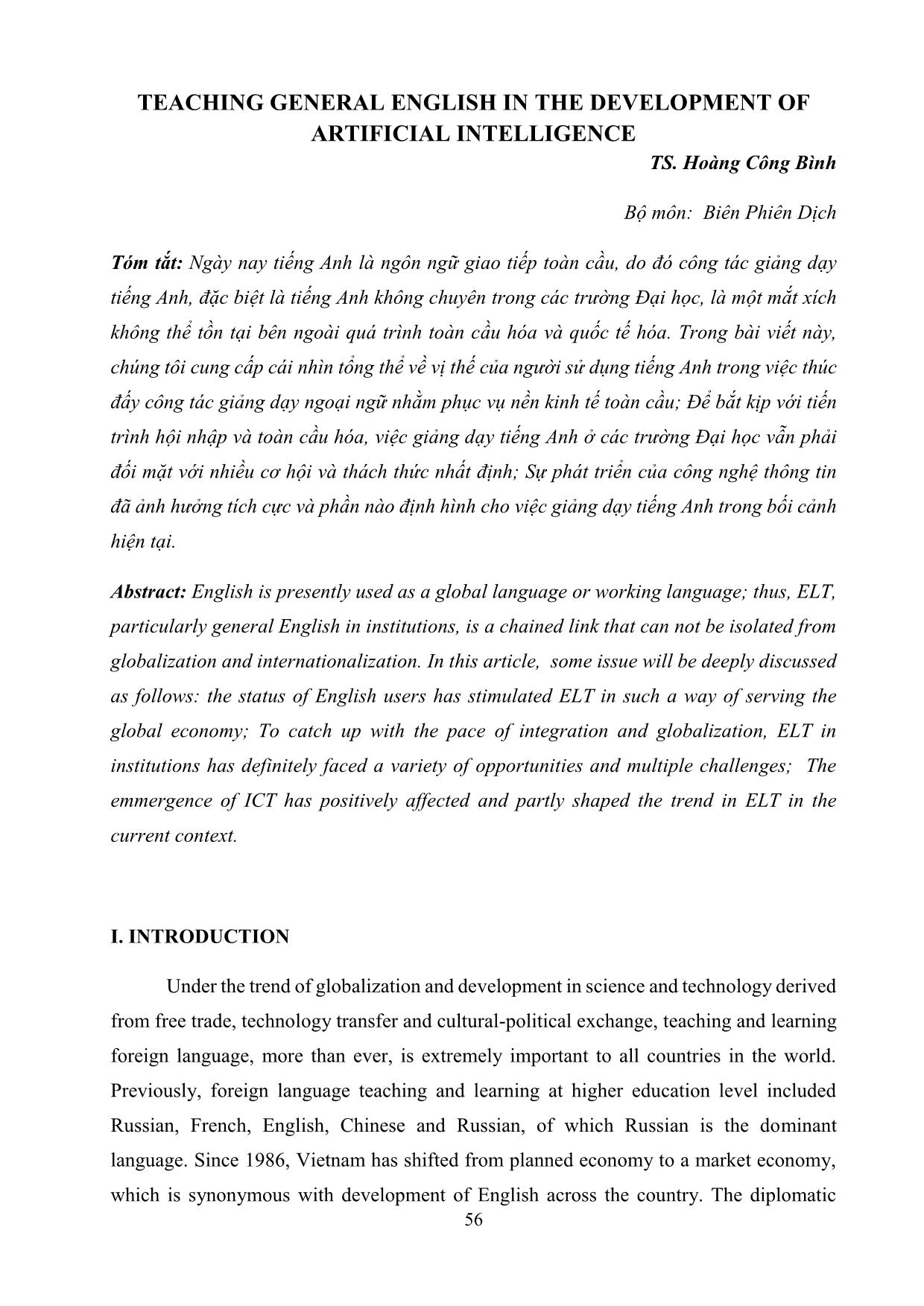
Trang 1
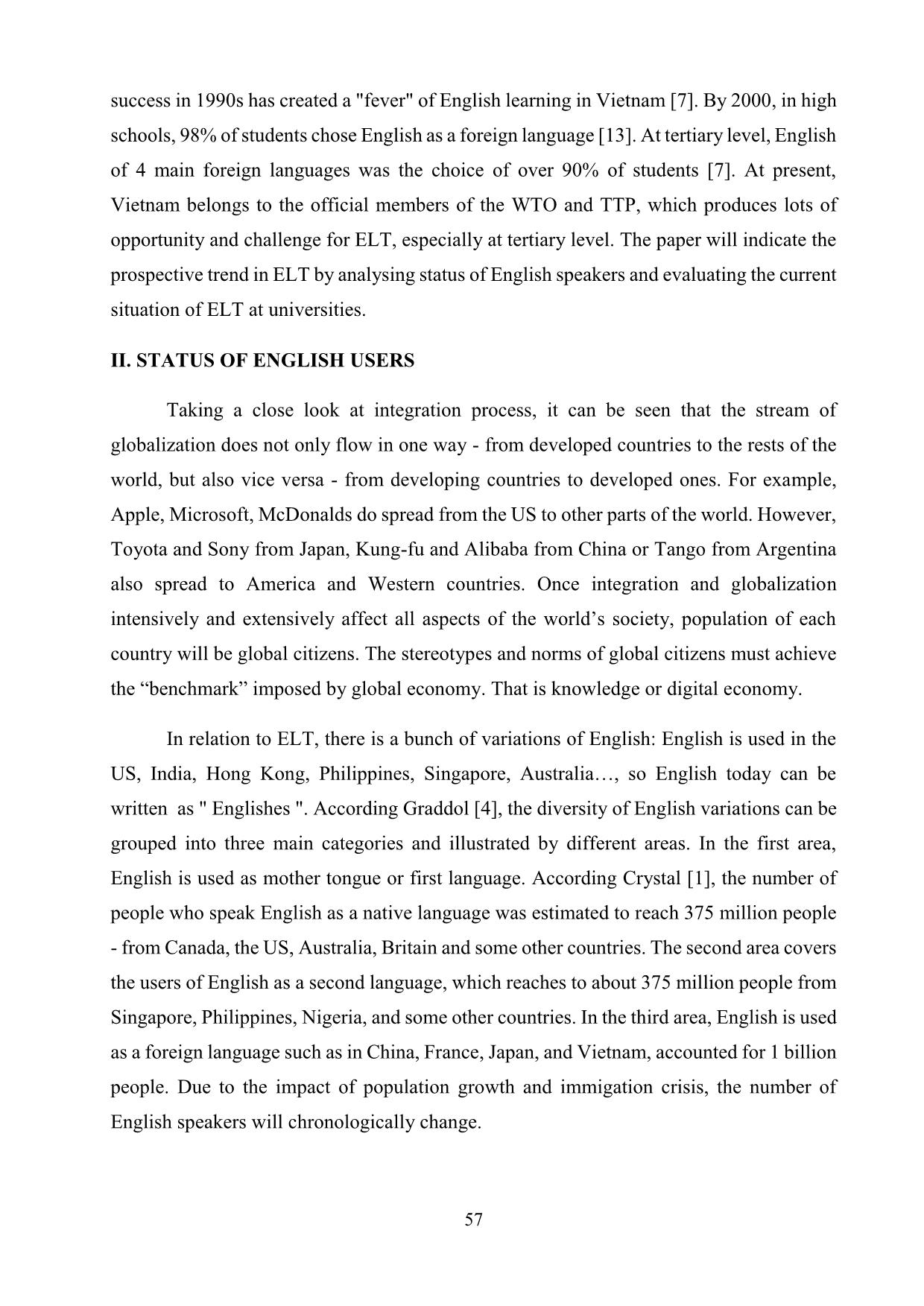
Trang 2

Trang 3
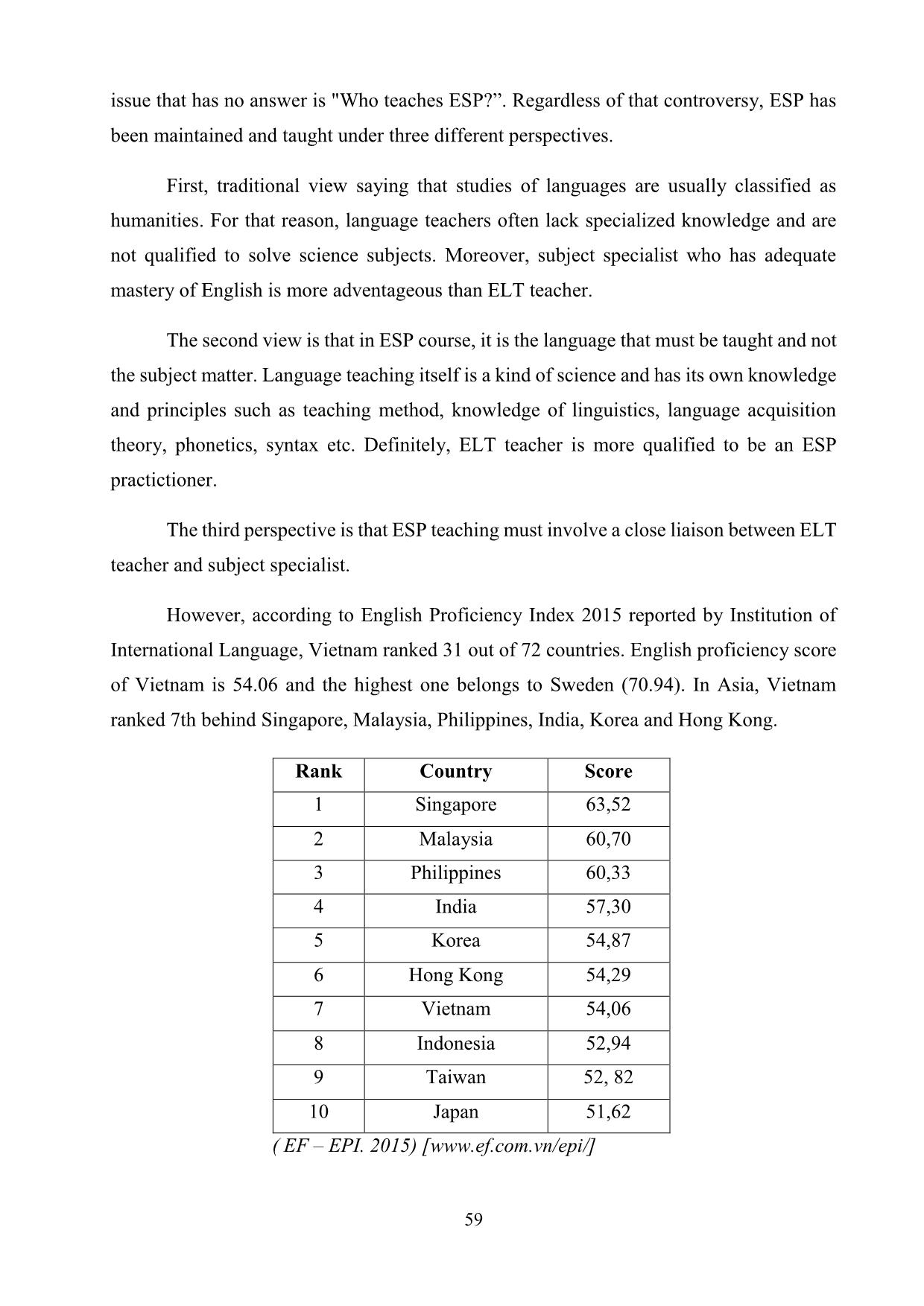
Trang 4

Trang 5
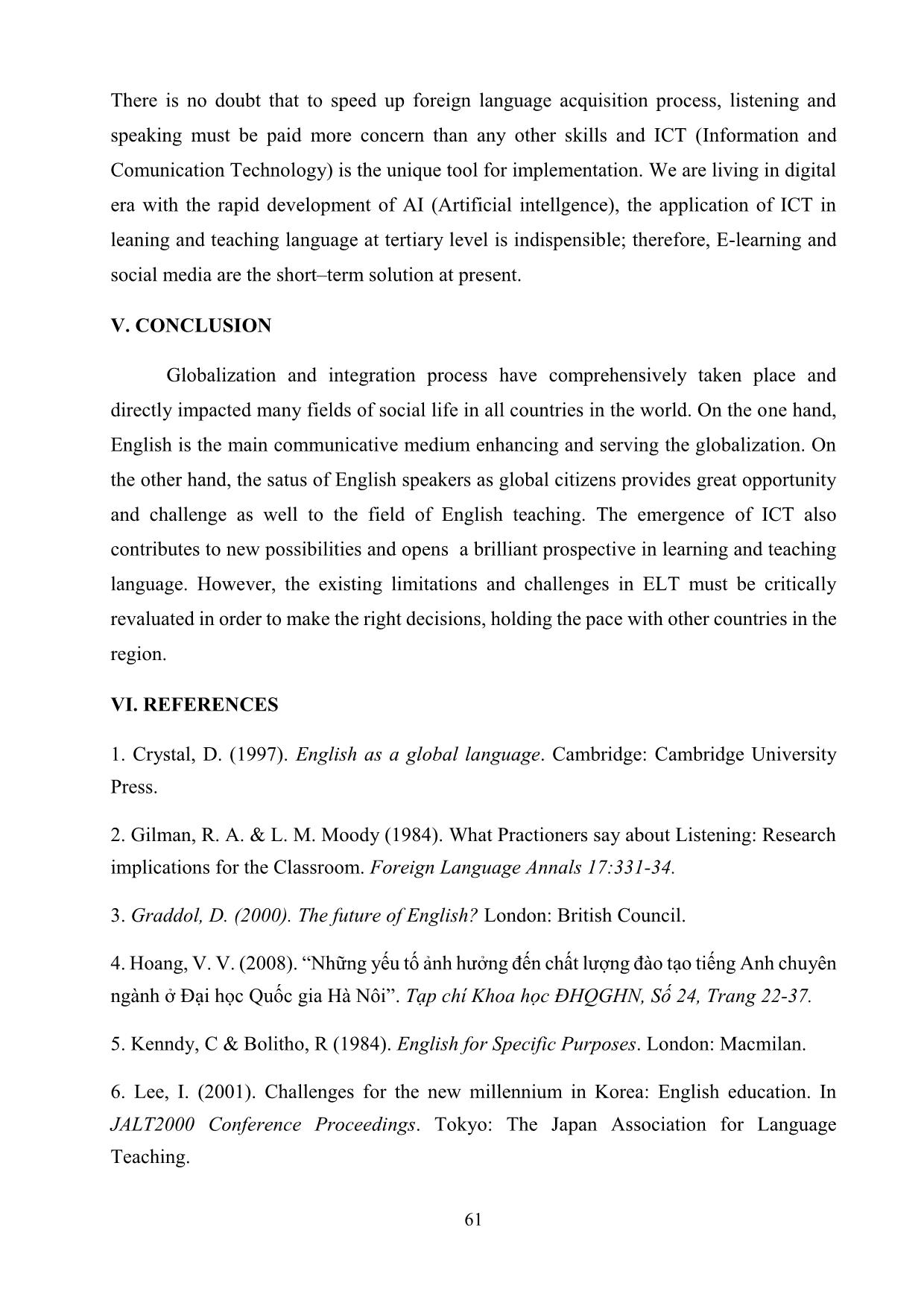
Trang 6
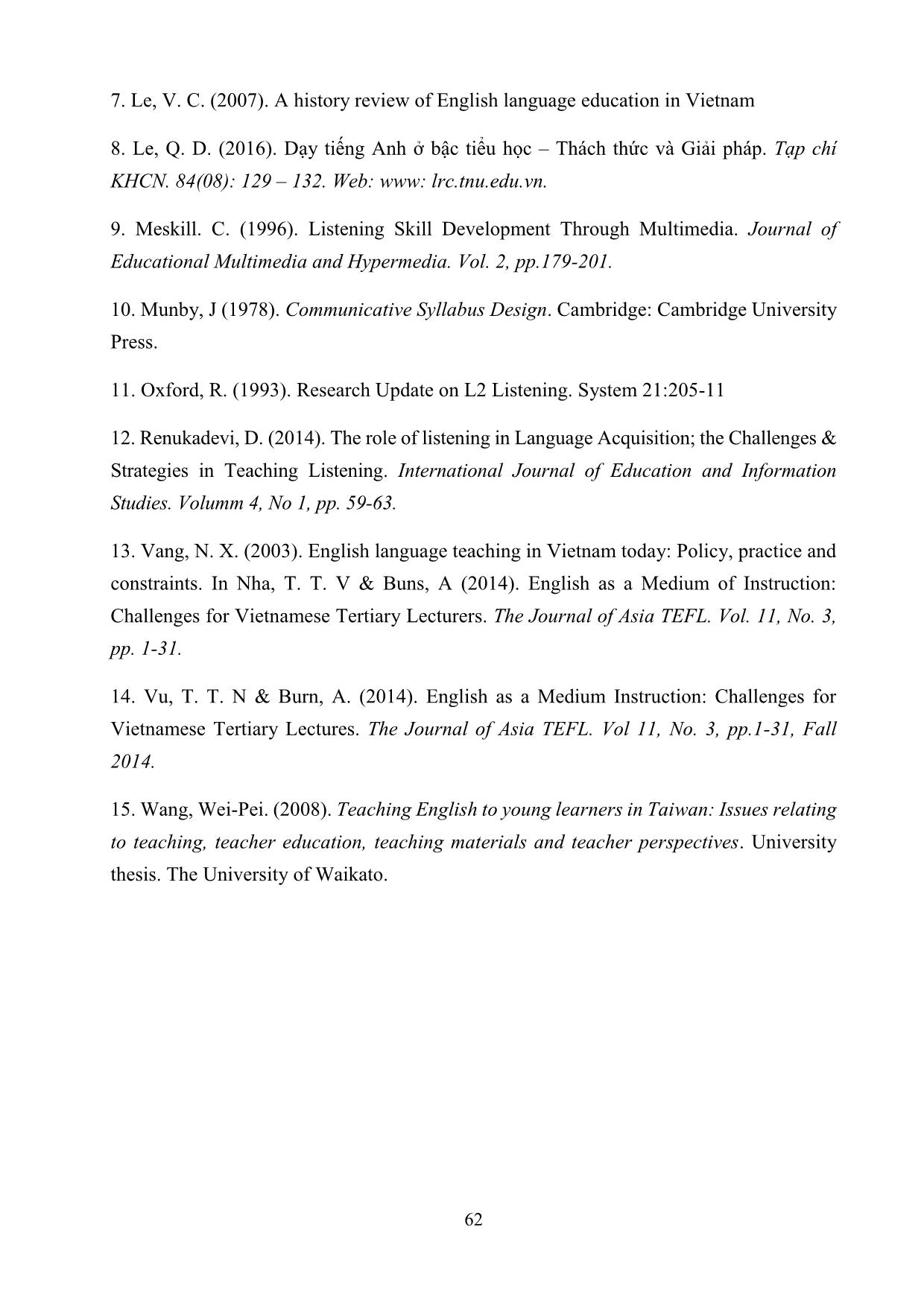
Trang 7
Tóm tắt nội dung tài liệu: Teaching general english in the development of artificial intelligence
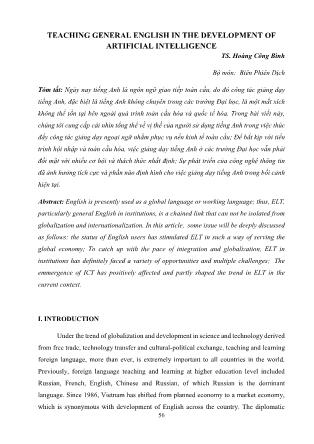
56 TEACHING GENERAL ENGLISH IN THE DEVELOPMENT OF ARTIFICIAL INTELLIGENCE TS. Hoàng Công Bình Bộ môn: Biên Phiên Dịch Tóm tắt: Ngày nay tiếng Anh là ngôn ngữ giao tiếp toàn cầu, do đó công tác giảng dạy tiếng Anh, đặc biệt là tiếng Anh không chuyên trong các trường Đại học, là một mắt xích không thể tồn tại bên ngoài quá trình toàn cầu hóa và quốc tế hóa. Trong bài viết này, chúng tôi cung cấp cái nhìn tổng thể về vị thế của người sử dụng tiếng Anh trong việc thúc đấy công tác giảng dạy ngoại ngữ nhằm phục vụ nền kinh tế toàn cầu; Để bắt kịp với tiến trình hội nhập và toàn cầu hóa, việc giảng dạy tiếng Anh ở các trường Đại học vẫn phải đối mặt với nhiều cơ hội và thách thức nhất định; Sự phát triển của công nghệ thông tin đã ảnh hưởng tích cực và phần nào định hình cho việc giảng dạy tiếng Anh trong bối cảnh hiện tại. Abstract: English is presently used as a global language or working language; thus, ELT, particularly general English in institutions, is a chained link that can not be isolated from globalization and internationalization. In this article, some issue will be deeply discussed as follows: the status of English users has stimulated ELT in such a way of serving the global economy; To catch up with the pace of integration and globalization, ELT in institutions has definitely faced a variety of opportunities and multiple challenges; The emmergence of ICT has positively affected and partly shaped the trend in ELT in the current context. I. INTRODUCTION Under the trend of globalization and development in science and technology derived from free trade, technology transfer and cultural-political exchange, teaching and learning foreign language, more than ever, is extremely important to all countries in the world. Previously, foreign language teaching and learning at higher education level included Russian, French, English, Chinese and Russian, of which Russian is the dominant language. Since 1986, Vietnam has shifted from planned economy to a market economy, which is synonymous with development of English across the country. The diplomatic 57 success in 1990s has created a "fever" of English learning in Vietnam [7]. By 2000, in high schools, 98% of students chose English as a foreign language [13]. At tertiary level, English of 4 main foreign languages was the choice of over 90% of students [7]. At present, Vietnam belongs to the official members of the WTO and TTP, which produces lots of opportunity and challenge for ELT, especially at tertiary level. The paper will indicate the prospective trend in ELT by analysing status of English speakers and evaluating the current situation of ELT at universities. II. STATUS OF ENGLISH USERS Taking a close look at integration process, it can be seen that the stream of globalization does not only flow in one way - from developed countries to the rests of the world, but also vice versa - from developing countries to developed ones. For example, Apple, Microsoft, McDonalds do spread from the US to other parts of the world. However, Toyota and Sony from Japan, Kung-fu and Alibaba from China or Tango from Argentina also spread to America and Western countries. Once integration and globalization intensively and extensively affect all aspects of the world’s society, population of each country will be global citizens. The stereotypes and norms of global citizens must achieve the “benchmark” imposed by global economy. That is knowledge or digital economy. In relation to ELT, there is a bunch of variations of English: English is used in the US, India, Hong Kong, Philippines, Singapore, Australia, so English today can be written as " Englishes ". According Graddol [4], the diversity of English variations can be grouped into three main categories and illustrated by different areas. In the first area, English is used as mother tongue or first language. According Crystal [1], the number of people who speak English as a native language was estimated to reach 375 million people - from Canada, the US, Australia, Britain and some other countries. The second area covers the users of English as a second language, which reaches to about 375 million people from Singapore, Philippines, Nigeria, and some other countries. In the third area, English is used as a foreign language such as in China, France, Japan, and Vietnam, accounted for 1 billion people. Due to the impact of population growth and immigation crisis, the number of English speakers will chronologically change. 58 Under the shift of global context, ELT has also emerged many challenges and opportunities for the third countries. Consequently, the requirement of English proficiency urged many countries to abruptly apply English as a medium of instruction at elementary level. To illustrate, let’s see these examples. In South Korea, English is taught from primary level in 1982 [6]. Indonesia started in 1994 and Taiwan in 2002 [15]. In Vietnam, from 2010-2011, English was partly applied to the pilot curriculum from grade 3 in HCM city and Hanoi [8]. Apart from population growth and immigration crisis, ELT at primary level also contributes to a worldwide shift in proportion of English speakers and their English proficiency. Those who use English as a second language tend to use it as a native one and in the same way, people speaking English as a foreign language in non-English speaking countries tend to upgrade their English proficiency to status of second language speakers. This involves in a global shift of the speakers’ language competence from a lower level to another higher level. III. THE REALITY OF ELT AT UNIVERSIRTIES Before the issue of Foreign Language Competency Framework for Vietnam, ELT faced a variety of shortcomings and constraints affecting the quality of training. One of the remarkable causes was that learners’ proficiency was not identifed and allocated for each level from bachelor to doctorate [4]. At present, most universities has currently implemented the National Foreign Language 2020 Project and the goal of this project is to renovate language teaching and learning in order to create a society with competent language users for communication, study and work in integrated environment. Up to now, there has not been any studies on the results of ELT at tertiary level under the 2020 Project. In regard to the reality of ESP teaching, it has produced many difficulties and challenges related to learners, teachers, methodology, materials, testing and assessment. The movement of teaching and learning ESP initiated inVietnam from the 1980s, but most universities partly succeeded in teaching English for professional purposes like English for Tourism, Commerce, Bussiness, Reception and so on [4]. Undoubtedly, a controversial 59 issue that has no answer is "Who teaches ESP?”. Regardless of that controversy, ESP has been maintained and taught under three different perspectives. First, traditional view saying that studies of languages are usually classified as humanities. For that reason, language teachers often lack specialized knowledge and are not qualified to solve science subjects. Moreover, subject specialist who has adequate mastery of English is more adventageous than ELT teacher. The second view is that in ESP course, it is the language that must be taught and not the subject matter. Language teaching itself is a kind of science and has its own knowledge and principles such as teaching method, knowledge of linguistics, language acquisition theory, phonetics, syntax etc. Definitely, ELT teacher is more qualified to be an ESP practictioner. The third perspective is that ESP teaching must involve a close liaison between ELT teacher and subject specialist. However, according to English Proficiency Index 2015 reported by Institution of International Language, Vietnam ranked 31 out of 72 countries. English proficiency score of Vietnam is 54.06 and the highest one belongs to Sweden (70.94). In Asia, Vietnam ranked 7th behind Singapore, Malaysia, Philippines, India, Korea and Hong Kong. Rank Country Score 1 Singapore 63,52 2 Malaysia 60,70 3 Philippines 60,33 4 India 57,30 5 Korea 54,87 6 Hong Kong 54,29 7 Vietnam 54,06 8 Indonesia 52,94 9 Taiwan 52, 82 10 Japan 51,62 ( EF – EPI. 2015) [www.ef.com.vn/epi/] 60 If making a comparision between the nationwide regions, English proficiency in the Southeast region is (56.08), the Red River Delta (53.56) and the South-central provinces (48.97). Although English proficiency of Vietnam belongs to moderate ranking group, but in South Central Provinces, that score (48.97) is among the low rangking ones. IV. THE CURRENT TREND IN ELT The field of language education is rapidly changing and traditional notions of education are giving away to more innovative ways of thinking about how we learn, teach and acquire languages. If English as a language major is for those who deeply study in the field of language, General English, English for Specific Purposes and English as a medium instuction have more extensive and diverse stakeholders in Economics, Engineering, Natural Sciences and Social Sciences. The National Foreign Language Project targets a remarkable advance in the improvement of foreign language proficiency for the Vietnamese during the period from now to 2020. For tertiary education, graduates from university should reach level 3 (B1 or B2). To achieve this goal, both teachers and learners need to distinguish between knowledge and skills in language acquisition. Nowadays, development of information technology has great influence on ELT because learners are now tech-savvy students. Once resources and information are at finger tips, to master a language will not be a hard job for anyone as it was. Although the CLT method and integrated skills have been applied in language teaching, the allocation for language skills in ELT process has not taken into account in. According Renukadevi [12], in process of language acquisition, learner can acquire 45% from listening activities, 30% from speaking, 15% from reading and 10% from writing. Listening and reading comprehension, thus, outweight other skills, which means the input (receptive skills) is more important and indispensable than the output (productive skills) in language acquisition. Renukadevi [12] states that listening comprehension is the "macro" skill in learning a language. Dunkel (1991), Krashen (1995) and Rost (1993) regarded listening comprehension skill as a cornerstone to acquiring a second language [9]. Many studies have also proved that adults use 40-50% of time for communication, but to recognize the role of listening in language learning has been only found recently [11]. 61 There is no doubt that to speed up foreign language acquisition process, listening and speaking must be paid more concern than any other skills and ICT (Information and Comunication Technology) is the unique tool for implementation. We are living in digital era with the rapid development of AI (Artificial intellgence), the application of ICT in leaning and teaching language at tertiary level is indispensible; therefore, E-learning and social media are the short–term solution at present. V. CONCLUSION Globalization and integration process have comprehensively taken place and directly impacted many fields of social life in all countries in the world. On the one hand, English is the main communicative medium enhancing and serving the globalization. On the other hand, the satus of English speakers as global citizens provides great opportunity and challenge as well to the field of English teaching. The emergence of ICT also contributes to new possibilities and opens a brilliant prospective in learning and teaching language. However, the existing limitations and challenges in ELT must be critically revaluated in order to make the right decisions, holding the pace with other countries in the region. VI. REFERENCES 1. Crystal, D. (1997). English as a global language. Cambridge: Cambridge University Press. 2. Gilman, R. A. & L. M. Moody (1984). What Practioners say about Listening: Research implications for the Classroom. Foreign Language Annals 17:331-34. 3. Graddol, D. (2000). The future of English? London: British Council. 4. Hoang, V. V. (2008). “Những yếu tố ảnh hưởng đến chất lượng đào tạo tiếng Anh chuyên ngành ở Đại học Quốc gia Hà Nôi”. Tạp chí Khoa học ĐHQGHN, Số 24, Trang 22-37. 5. Kenndy, C & Bolitho, R (1984). English for Specific Purposes. London: Macmilan. 6. Lee, I. (2001). Challenges for the new millennium in Korea: English education. In JALT2000 Conference Proceedings. Tokyo: The Japan Association for Language Teaching. 62 7. Le, V. C. (2007). A history review of English language education in Vietnam 8. Le, Q. D. (2016). Dạy tiếng Anh ở bậc tiểu học – Thách thức và Giải pháp. Tạp chí KHCN. 84(08): 129 – 132. Web: www: lrc.tnu.edu.vn. 9. Meskill. C. (1996). Listening Skill Development Through Multimedia. Journal of Educational Multimedia and Hypermedia. Vol. 2, pp.179-201. 10. Munby, J (1978). Communicative Syllabus Design. Cambridge: Cambridge University Press. 11. Oxford, R. (1993). Research Update on L2 Listening. System 21:205-11 12. Renukadevi, D. (2014). The role of listening in Language Acquisition; the Challenges & Strategies in Teaching Listening. International Journal of Education and Information Studies. Volumm 4, No 1, pp. 59-63. 13. Vang, N. X. (2003). English language teaching in Vietnam today: Policy, practice and constraints. In Nha, T. T. V & Buns, A (2014). English as a Medium of Instruction: Challenges for Vietnamese Tertiary Lecturers. The Journal of Asia TEFL. Vol. 11, No. 3, pp. 1-31. 14. Vu, T. T. N & Burn, A. (2014). English as a Medium Instruction: Challenges for Vietnamese Tertiary Lectures. The Journal of Asia TEFL. Vol 11, No. 3, pp.1-31, Fall 2014. 15. Wang, Wei-Pei. (2008). Teaching English to young learners in Taiwan: Issues relating to teaching, teacher education, teaching materials and teacher perspectives. University thesis. The University of Waikato.
File đính kèm:
 teaching_general_english_in_the_development_of_artificial_in.pdf
teaching_general_english_in_the_development_of_artificial_in.pdf

